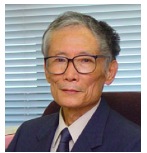
Professor Jun Kondo
Fellow Emeritus
National Institute of Advanced Industrial Science and Technology
(AIST)

Professor Jun Kondo
Fellow Emeritus
National Institute of Advanced Industrial Science and Technology
(AIST)
|
It is well known that the electrical resistivity of metals decreases with lowering temperature. The resistence minumum found for dilute magnetic alloys is, however, against this normal behavior, showing that the electrical resistivity increases at low temperatures. The origin of this anomalous behavior had been the long-standing mystery for a long time. It was Professor Dr. J. Kondo that solved this mystery from a careful consideration on the model where the conduction electrons interact with the localized spin through the exchange coupling J. The resistence minimum was successfully explained by the anomalous logarithmic term, log(T), which arises from the higher-order perturbative interactions. The increase of resistivity due to dilute magnetic impurities, with the logarithmic temperature dependence, is called the Kondo effect. The model with the interaction between the localized spin and conduction electrons, called the Kondo model or s-d model, is now the universal and important model in solid state physics. The solution of the resistence
minimum has presented a new problem which is concerned with the
zero-temperature limit of the resistivity, since the
resistivity of metals with dilute magnetic impurities is finite at absolute zero (T = 0). This is the Kondo problem which has given
enormous effects on all over the physics from high-energy physics
to low-energy (low-temperature) physics. |